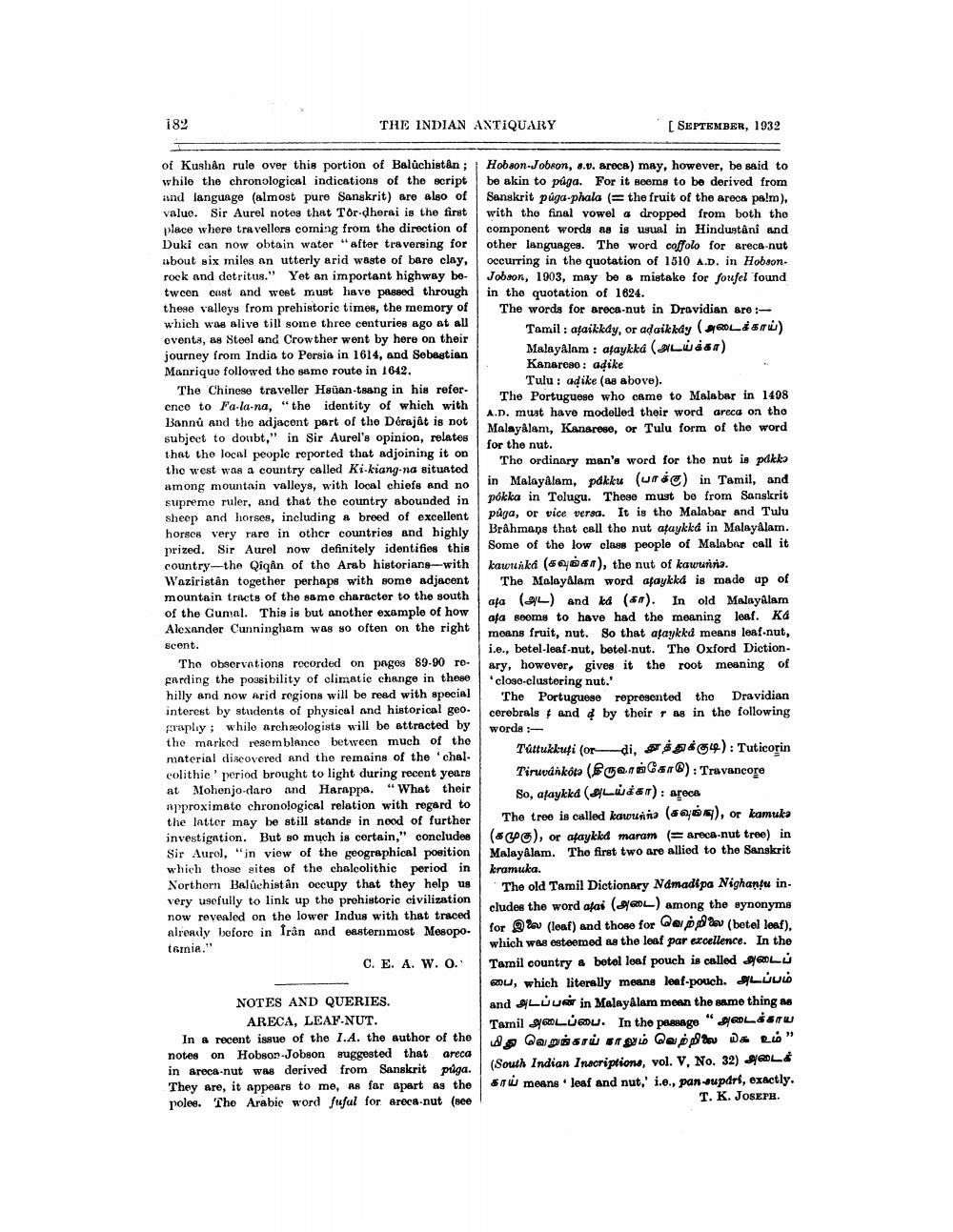________________
182
THE INDIAN ANTIQUARY
of Kushan rule over this portion of Baluchistan; while the chronological indications of the script and language (almost pure Sanskrit) are also of value. Sir Aurel notes that Tor-dherai is the first place where travellers coming from the direction of Duki can now obtain water "after traversing for about six miles an utterly arid waste of bare clay, rock and detritus." Yet an important highway between east and west must have passed through these valleys from prehistoric times, the memory of which was alive till some three centuries ago at all events, as Steel and Crowther went by here on their journey from India to Persia in 1614, and Sebastian Manrique followed the same route in 1642.
The Chinese traveller Hsuan-tsang in his refer ence to Fa-la-na, "the identity of which with Bannû and the adjacent part of the Dérajât is not subject to doubt," in Sir Aurel's opinion, relates that the local people reported that adjoining it on the west was a country called Ki-kiang-na situated among mountain valleys, with local chiefs and no supreme ruler, and that the country abounded in sheep and horses, including a breed of excellent horses very rare in other countries and highly prized. Sir Aurel now definitely identifies this country-the Qiqån of the Arab historians-with Waziristan together perhaps with some adjacent mountain tracts of the same character to the south of the Gumal. This is but another example of how Alexander Cunningham was so often on the right
scent.
The observations recorded on pages 89-90 regarding the possibility of climatic change in these hilly and now arid regions will be read with special interest by students of physical and historical geography; while archaeologists will be attracted by the marked resemblance between much of the material discovered and the remains of the chaleolithic period brought to light during recent years at Mohenjo-daro and Harappa. "What their approximate chronological relation with regard to the latter may be still stands in neod of further investigation. But so much is certain," concludes Sir Aurol, "in view of the geographical position which those sites of the chalcolithic period in Northern Baluchistan occupy that they help us very usefully to link up the prehistoric civilization now revealed on the lower Indus with that traced already before in Trân and easternmost Mesopotamia."
C. E. A. W. O.
NOTES AND QUERIES.
ARECA, LEAF-NUT.
In a recent issue of the I.A. the author of the notes on Hobson-Jobson suggested that areca in areca-nut was derived from Sanskrit púga. They are, it appears to me, as far apart as the poles. The Arabic word fuful for areca-nut (see
[SEPTEMBER, 1932
Hobson-Jobson, s.v. areca) may, however, be said to be akin to pûga. For it seems to be derived from Sanskrit púga-phala (= the fruit of the areca palm), with the final vowel a dropped from both the component words as is usual in Hindustani and other languages. The word coffolo for areca-nut occurring in the quotation of 1510 A.D. in HobsonJobson, 1903, may be a mistake for foufel found in the quotation of 1624.
The words for areca-nut in Dravidian are:
Tamil: afaikkdy, or aḍaikkdy (sr) Malayalam: ataykká (Lisa) Kanareso: adike
Tulu: adike (as above).
The Portuguese who came to Malabar in 1498 A.D. must have modelled their word areca on the Malayalam, Kanarese, or Tulu form of the word for the nut.
The ordinary man's word for the nut is pakka in Malayalam, pákku (uri) in Tamil, and pókka in Telugu. These must be from Sanskrit púga, or vice versa. It is the Malabar and Tulu Brahmans that call the nut ataykká in Malayalam. Some of the low class people of Malabar call it kawunká (5), the nut of kawunnə.
The Malayalam word ataykká is made up of afa (L) and ká (4). In old Malayalam afa seems to have had the meaning leaf. Ká means fruit, nut. So that ataykká means leaf-nut, i.e., betel-leaf-nut, betel-nut. The Oxford Dictionary, however, gives it the root meaning of 'close-clustering nut.'
The Portuguese represented the Dravidian cerebrals and 4 by their r as in the following words :
Tuttukkuti (ordi, 4): Tuticorin Tiruvankóta (Can): Travancore So, alaykká (a): areca
The tree is called kawunne (), or kamuka (8), or ataykká maram (areca-nut tree) in Malayalam. The first two are allied to the Sanskrit kramuka.
The old Tamil Dictionary Námadipa Nighantu includes the word afai (L) among the synonyms for (leaf) and those for Qap (betel leaf).
which was esteemed as the leaf par excellence. In the Tamil country a betel leaf pouch is called
, which literally means leaf-pouch. Lui and Luur in Malayalam mean the same thing as
46
Tamil L. In the passage அடைக்காய மிது வெறுங்காய் நாலும் வெற்றிலை யக உம்' (South Indian Inscriptions, vol. V, No. 32) L s means leaf and nut,' i.e., pan-supárs, exactly. T. K. JOSEPH.




